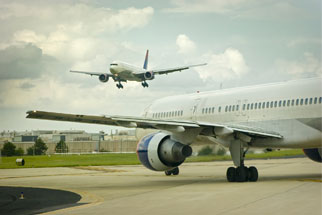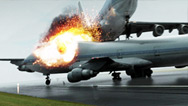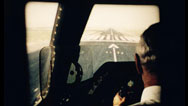Accident-Proof Runways?
- By David Levin
- Posted 10.17.06
- NOVA
Taxiing an aircraft on the ground can be one of the most dangerous parts of flying. Even with a strict set of commands from the control tower, it is still possible for planes and ground vehicles to end up on the wrong runway at the wrong time. In this audio story, find out how new airport radar systems could help prevent so-called "runway incursions," including those that lead to crashes.
 Listen
Listen
Find out how new airport radar systems could help prevent runway incursions—and crashes—on the tarmac.
Transcript
Accident-Proof Runways?
Posted October 17, 2006
DAVID LEVIN: Taxiing an aircraft on the ground is a slow and steady procedure, but it can be the one of the most dangerous parts of flying. Even with a strict set of commands from the control tower, it's still possible for planes and ground vehicles to end up on the wrong runway at the wrong time. Mistakes like these are called "runway incursions"—and they happen more often than you'd think.
MARK ROSENKER: We're seeing something like 325 of them a year. That's too many. The possibilities are too great for a collision, for an accident, where many deaths could be a result.
DAVID LEVIN: Mark Rosenker is the chair of the National Transportation Safety Board. His group has recommended updates to existing radar at major US airports to help prevent runway incursions. The newest technology, called "ASDE-X", shows where planes are on the field no matter how bad visibility gets. It's already in place at a few busy locations, like T.F. Green Airport in Providence, RI.
TOM LAFEN: What you're seeing now is a Southwest jet about to touch down on the runway. It's a Boeing 737.
DAVID LEVIN: In the Providence Tower, operations manager Tom Lafen points out moving planes on a radar screen.
TOM LAFEN: ASDE-X gives the controllers a pair of eyes to see through the fog, to see at nighttime. It paints a picture, it shows where aircraft and vehicles are to help the controller prevent collisions and accidental entries on to runways. In a congested airport it is an excellent tool that allows the controller to keep visual track of the aircraft, not only out the window, but on the radar scope.
DAVID LEVIN: The ASDE-X system will also sound an alarm in the tower whenever aircraft are in danger of colliding. Right now, only air traffic controllers can see and hear ASDE-X warnings, and have to alert pilots if there's a problem. But Mark Rosenker thinks that might not be fast enough in a real emergency.
MARK ROSENKER: It takes time for the controller to understand what he's seen, analyze the situation, communicate to the pilots where the incursion is. Those are seconds, those are precious seconds, which could be the difference between a safe takeoff and a catastrophic collision.
DAVID LEVIN: The best solution, Rosenker says, would be to cut out the middle-man and get feedback right to the cockpit so pilots can act quickly if needed.
At the Dallas/Fort Worth airport, the Federal Aviation Administration is testing a new technology that could solve this problem. A set of red lights connected to ground radar will tell pilots when a runway is unsafe to enter, cross or take off. The lights will be installed in the pavement at runway intersections, and at departure areas, where planes start their takeoff roll.
Jaime Figuaroa is a surface systems manager for the FAA, and leads a team working on the project.
JAIME FIGUAROA: It uses the same equipment that air traffic controllers currently use to track the movement of airplanes on the airport surface, and takes that information through computer processing, detects when a conflict is going to develop, and illuminates a visual signal, a traffic light if you will, to signal to pilots that there is a conflict on the runway.
DAVID LEVIN: And, he says, trials in Dallas are looking good. More tests are already being done at San Diego International, and if everything goes well, the FAA may install the lights at other big airports in the next few years. Until then, pilots and controllers will have to watch for incursions the old fashioned way.
For NOVA, I'm David Levin.
Credits
Image
- (airplanes on runway)
- © iStockphoto/Lars Lindblad
Related Links
-

The Deadliest Plane Crash
NOVA investigates the worst aviation accident of all time.
-

Making Air Travel Safer
Horrifying as they are, the worst airline accidents spark the most safety improvements.
-

How Risky Is Flying?
Harvard's David Ropeik explains why judging risk is a risky business.
-

Pilot Room For Error
With airline flight increasingly automated, to what degree can human fallibility still creep in?
You need the Flash Player plug-in to view this content.

